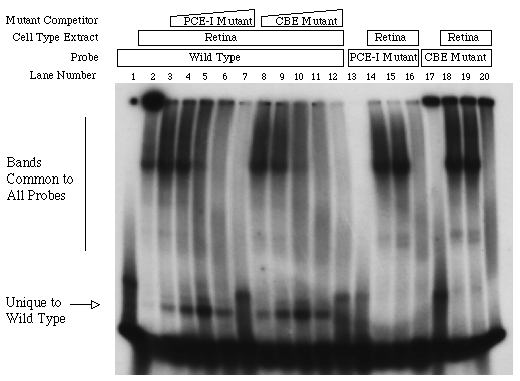![]() Figure 13 of
Boatright, Mol Vis 3:15, 1997.
Figure 13 of
Boatright, Mol Vis 3:15, 1997.
Figure 13. EMSA of the effects of transversion mutation of either Ret-1/PCE-I or the CRX-binding element.
Radiolabeled wild type probe was co-incubated with increasing concentrations of unlabeled activator sequence with either Ret-1/PCE-I mutated or the CRX-binding element (CBE) mutated. As with the experiment in Figure 12, complexes common to wild type and mutant sequence diminished with an increasing excess of unlabeled mutant probe. The intensity of the wild type-specific band lessened only at the highest concentration of either mutant. These data indicate that both putative elements must be intact for the activator-specific complex to bind. The last eight lanes (13-20) have one or the other of the mutants as radiolabeled probe. Lane 13 is the probe with Ret-1/PCE-I mutated (intact CRX-binding element) without extract. Lane 14 is this probe incubated with extract. Lane 15 is lane 14 conditions with 6.25 µg/µl S-119. Lane 16 is lane 15 conditions co-incubated with a 100 fold excess of unlabeled activator sequences with the CRX-binding element mutated (Ret-1/PCE-I intact). Lanes 17-20 are the same as lanes 13-16 except the roles are reversed for the two mutant sequences. Lanes 14, 15, 18, and 19 have upper bands common to all probes, but lack the activator-specific probe. These data indicate that both putative elements must be intact for the activator-specific complex to bind.
